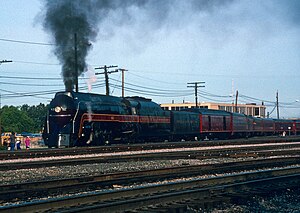Great Dismal Swamp train derailment
| Great Dismal Swamp train derailment | |
|---|---|
 Norfolk and Western 611, the locomotive involved in the derailment | |
| Details | |
| Date | May 18, 1986 02:09 p.m. |
| Location | Suffolk, Virginia |
| Country | United States |
| Line | Norfolk District |
| Operator | Norfolk Southern Railway |
| Service | Passenger train |
| Incident type | Derailment |
| Cause | Misaligned switch |
| Statistics | |
| Trains | 1 |
| Passengers | 1000 |
| Injured | 177 |
| References:[1] | |
The Great Dismal Swamp train derailment occurred on the afternoon of May 18, 1986, when a special Norfolk Southern employee passenger train derailed at the Great Dismal Swamp near Suffolk, Virginia. The accident injured 177 passengers; 18 were seriously injured and need to be airlifted to nearby hospitals in Norfolk, Virginia. The train was pulled by Norfolk and Western 611, a class J 4-8-4 steam locomotive, which was restored to operating condition for excursion service in 1982.
Accident
[edit]On the afternoon of May 18, 1986, at 1:31 P.M., class J 4-8-4 No. 611 departed Norfolk, Virginia, pulling a Norfolk Southern (NS) excursion train to Petersburg, Virginia. The train consisted of 23 passenger cars with Robert B. Claytor at the throttle.[2][3] When the train was running at 58 mph (93 km/h) near the Great Dismal Swamp in Suffolk, Virginia, two of the passenger cars struck a faulty switch on the main line derailing them and the other 12 passenger cars with them.[4] The locomotive, first six cars, and last two cars stayed on the rails undamaged.[4][1] 177 passengers were injured while 18 of the most seriously injured need to be airlifted to hospitals in Norfolk for treatment.[1][5] Eleven of the derailed passenger cars were repaired, but the two open-air cars, the Missionary Ridge and Queen and Crescent Club were a total loss and scrapped.[5] The other damaged car; the W. Graham Claytor, Jr., was donated to the VMT.[5][6] After the wreck, NS decided to limit the steam locomotives, including No. 611, to 40 mph (64 km/h) while pulling excursions on their rails.[5]
See also
[edit]References
[edit]- ^ a b c Derailment of Steam Excursion Train Norfolk and Western Railway Company Train Extra 611 (PDF) (Report). National Transportation Safety Board. September 15, 1987. Archived from the original (PDF) on March 19, 2021. Retrieved August 28, 2023.
- ^ "News & Editorial Comment - NS in the swamp". Trains. Vol. 46, no. 10. Kalmbach Publishing. August 1986. pp. 6–7. Retrieved February 17, 2024.
- ^ "Railroad News Photos - NS to carry on". Trains. Vol. 46, no. 10. Kalmbach Publishing. August 1986. p. 12. Retrieved February 17, 2024.
- ^ a b Wrinn (2000), pp. 74–75.
- ^ a b c d Wrinn (2000), p. 76.
- ^ "Passenger Car Southern Coach "W. Graham Claytor, Jr." Car #1070". Virginia Museum of Transportation. Archived from the original on September 2, 2016. Retrieved February 24, 2024.
Bibliography
[edit]- Wrinn, Jim (2000). Steam's Camelot: Southern and Norfolk Southern Excursions in Color (1st ed.). TLC Publishing. ISBN 1-883089-56-5.
